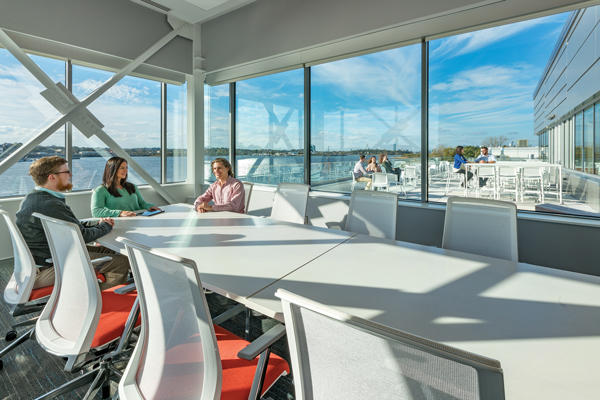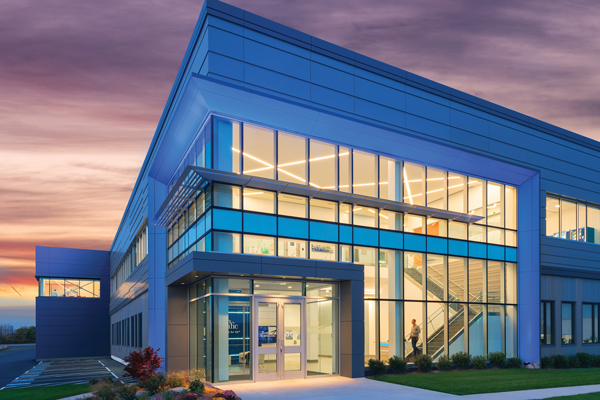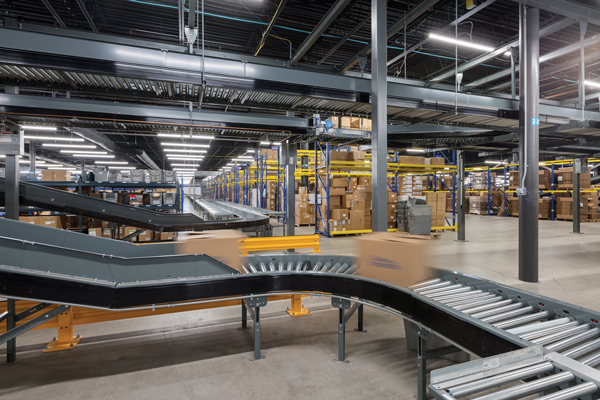Boston Scientific's Global Customer Fulfillment Center

A global facilities master plan informs the company’s real estate decisions.
CORPORATE REAL ESTATE planning is both a science and an art, an endeavor made more complicated by a large organization’s size and scope. Boston Scientific Corp., a worldwide developer, manufacturer and marketer of medical technology, has made a commitment to adopting a master planning approach to its global real estate, facility management and sustainability initiatives. A $9 billion company headquartered in Marlborough, Massachusetts, Boston Scientific has 27,000 employees and a global real estate portfolio spanning more than 150 properties and 9 million square feet of owned and leased property.

The design transformed an outdated warehouse building into an attractive, energy-efficient and natural light-filled office and fulfillment facility; the project was a major part of the Boston Scientific Global Facilities Master Plan.
Boston Scientific’s global real estate and facilities (GREFAC) team manages all construction, design, lease renewal and relocation projects in more than 40 countries. In 2012, the company tasked this team with developing a master plan and global design guidelines to align with the vision of the new CEO and executive leadership team. The GREFAC team engaged Boston-based Margulies Perruzzi Architects (MPA) to help evaluate its real estate choices, develop global workplace guidelines and design key facilities.
Fueling Growth
The Boston Scientific Global Facilities Master Plan is an enterprisewide initiative that brings the company’s real estate and workplace portfolio in line with its global business strategy through 2020. The plan offers sufficient flexibility to accommodate anticipated change; creates a work environment that promotes productivity, innovation and collaboration; and provides for continuous improvement in a cost-effective manner.
The strategy behind the plan is to “fund the journey to fuel the growth,” namely by reducing the company’s real estate footprint and by improving the use of space across its global portfolio to reduce operating expenses and to finance facility investments that attract and retain key talent. The strategy involves three phases: prune, invest, and sustain and maintain.
1) The prune phase focuses on eliminating poorly utilized real estate assets and reducing global energy consumption.
2) The invest phase uses the proceeds from the sale of excess real estate to invest in the remaining core assets that support global workplace strategy. It also provides a comprehensive set of global design guidelines for workplace design standards, branding, LEED and working remotely.
3) The sustain and maintain phase involves meeting annually with site, business and regional leaders at strategic global locations to understand what investments are needed to position them to support business goals in the future.
After developing the global design guidelines with Boston Scientific in 2012, MPA completed the design of a new 110,000-square-foot global headquarters on the company’s existing campus in Marlborough. Boston Scientific tapped MPA again to bring its second-largest Massachusetts facility – in Quincy – up to the company’s current global standard.
From Warehouse to Fulfillment Center
Renovating and repurposing a building can involve several factors: preserving existing features, updating building infrastructure and energizing spaces for new uses. Warehouses offer their own challenges, especially “legacy” buildings that have long been obsolete. An outdated warehouse in a high-profile location in Quincy has been transformed into a new 694,000-square-foot global customer fulfillment center for Boston Scientific. Completed in September 2017, this state-of-the-art energy-efficient facility expands and modernizes the company’s logistics and distribution functions and aligns with the Global Facilities Master Plan.
In 1998, Boston Scientific purchased the roughly 1.2 million-square-foot two-building warehouse complex on Quincy’s Squantum Point. Located on the Neponset River and visible from Interstate 93 on approach to Boston, the buildings served from 1970 to 1997 as warehouses for department store Jordan Marsh & Co. Since 1998, Boston Scientific has occupied both buildings on the site.
The GREFAC team recognized that the Quincy site had about 450,000 square feet of excess real estate, mostly in the north building, which cost $2.1 million annually to operate and would require an additional $13 million in deferred maintenance and upgrades. As part of the Global Facilities Master Plan, the company sought to consolidate its operational and distribution functions into a new customer fulfillment facility in the south building of the complex. More than 75 percent of the total units for global products, including medical devices such as life-saving stents, will move annually through the 24-hour fulfillment facility, which employs 450 people.
The Global Real Estate team developed a plan to sell off the underutilized real estate in the north building to help finance the new fulfillment facility in the south building. The sale required the complete separation of the north and south buildings, which were two interconnected properties. The buildings were decoupled by severing all common structural and utility systems between them and by dividing the land lots, thereby creating two separate parcels, with approval by the municipality.
In 2016, Boston Scientific sold the north building to Scannell Properties for $31 million, retaining ownership of the south building. As part of the transaction, Boston Scientific executed a 21-month lease in the north building, occupying it as swing space during renovation of the south building. The sale lease-back saved Boston Scientific $7.2 million in operating expenses and $13 million in deferred maintenance costs. The proceeds from the sale of the north building enabled Boston Scientific to stay cash neutral and reinvest in distribution technology and workplace strategy for the new facility in the south building that will save $2.1 million in annual operating expenses.
Designing for New Uses
MPA inherited legacy warehouse conditions that guided the repositioning of the south building. The existing loading docks were retained, while the adjacent area’s flow was reconfigured to accommodate a new employee entrance. The building’s precast facade was completely replaced with an energy-efficient, metal-panel rain screen system and new high-efficiency ribbon windows. The corner of the building was removed and updated with a multistory curtain wall glass facade with blue exterior LED accent lighting to create a dramatic canopied main entry.

MPA’s design features a modern, energy-efficient and state-of-the-art distribution and logistics facility with a high-performance workplace, prompting Boston Scientific to view the building as its regional hub.
The 630,000-square-foot customer fulfillment center includes 2.5 miles of high-efficiency, “smart technology” conveyor systems and Boston Scientific’s first installation of an enterprise warehouse management system to optimize inventory management and distribution operations. The project team designed a sophisticated logistics facility that will provide operational cost savings through increased productivity and energy efficiency. For the installed utility upgrades, Boston Scientific received one of the largest energy rebates in New England: $1.1 million. The sustainably designed building is expected to achieve LEED Gold certification for existing buildings, and the company is pursuing a WELL Building Design certification to ensure employee health and wellness in the Quincy facility.
The building’s 64,000 square feet of office space were designed to meet global workplace strategy standards that Boston Scientific is deploying around the world. As part of its change management efforts, the company has shifted to smaller workstations and more open and collaborative workspaces. The open office space features a mix of workstations and glass-fronted offices supported by town squares, breakout cafes, training spaces and a variety of meeting rooms. The workplace environment was designed to attract and retain employees by providing natural light, increased collaboration space, custom artwork, and upgraded furniture and finishes. It also offers employees modern amenities such as a corporate cafe, a rooftop terrace, a full service fitness center and an impressive new entrance, which opens into a light-filled lobby.
Overcoming Challenges
The design team’s primary challenges involved space constraints, workflow and stretching the $31 million budget. The design needed to mesh 64,000 square feet of high-performance office space with 630,000 square feet of warehouse and distribution space. This connection was critical to ensure optimal flows of goods and people as well full system compliance in an FDA-regulated facility. Completing the construction on time was critical as delivery of the building needed to align with termination of Boston Scientific’s 21-month leaseback in the north building. Additionally, delivery needed to correspond with a product migration schedule to ensure seamless logistical operations.
Additional construction challenges included renovating the facility on an occupied, functional campus affected by winter weather. The construction team was also required to work within the insurer’s stringent environmental, health and safety regulations, which were more demanding than those required by the local building code.
The design team also addressed numerous other issues associated with a large multiuse building by doing the following: 1) examining where employees park and how they enter the building, 2) providing security for a building with dual industrial and office uses, 3) incorporating a fitness center while minimizing noise and impact vibrations and 4) safely and efficiently integrating a huge volume of truck traffic with passenger cars.
Creating a Regional Hub
Converting an aging warehouse into a combined office and logistics facility is a complex undertaking. The design team studied the building’s structural weight and flooring capacities, as the retrofit had to accommodate more than $4 billion of medical device products shipped through the Quincy facility each year. The space with higher slab capacity was clearly designated for fulfillment activities. Adjacency and acoustical issues were addressed to merge office functions with two levels of warehouse and logistics operations, separating office workers from forklifts that operated just 5 feet away.

The multi-level warehouse at Boston Scientific’s new headquarters in Quincy, Massachusetts, includes a high-efficiency, “smart technology” conveyor system and the company’s first enterprise warehouse management system.
Wherever possible, the design kept and incorporated elements of the existing building, such as the roof, steel and floors. The team took advantage of the existing building geometry to create a new rooftop deck with spectacular views of Boston. The design of the outside space required careful planning to ensure that the existing structure would support the weight of the deck. For the new corner entry, the design team cut out the floor slab of the existing structure to accommodate a two-story lobby. Raw warehouse space and a mezzanine were converted into new office space, and MPA was able to insert windows where there hadn’t been any before.
Boston Scientific was sensitive to the building’s history and sought to retain distinctive building characteristics. Rather than hiding them, the design team incorporated the existing structural cross-bracings into the design by exposing, painting and making them a feature. Although modern in design, these legacy features celebrate the building’s industrial past.
The Boston Scientific Global Customer Fulfillment Center was intended to do two things well: 1) provide a modern, state-of-the-art and energy-efficient logistics and distribution center and 2) offer a high-performance workspace in line with the company’s global workplace strategy standards. With its close proximity to Boston’s Logan Airport, ease of commute and ample parking, as well as extensive amenities for employees and visitors, the Quincy office has become an appealing location for Boston Scientific executives. The facility, which was completed on time and on budget, has evolved – in the minds of the company’s employees – into Boston Scientific’s regional hub.
Paul Donhauser, CEM, CPMM (Paul.Donhauser@bsci.com), is vice president of global real estate, facilities operations and environment, health and safety at Boston Scientific Corp. Marc Margulies, FAIA, LEED AP (mmargulies@mp-architects.com), is a principal and senior partner at Margulies Perruzzi Architects.
A Complex, Multistage ProjectThe Quincy facility was the most complex project the GREFAC team had tackled in many years. According to Peter Doig, the property’s facility manager, “the stars had to align” to complete this project in multiple, complicated stages:
|





